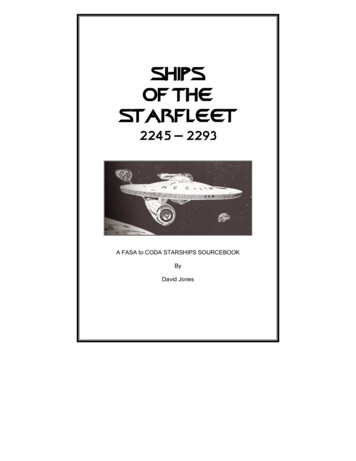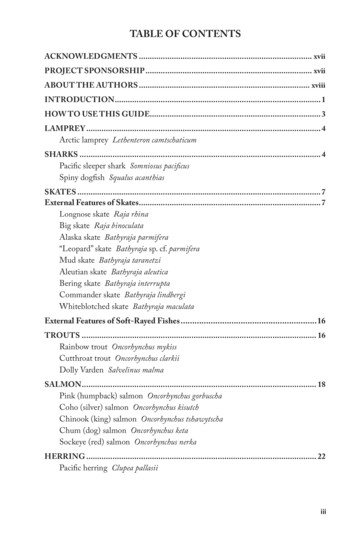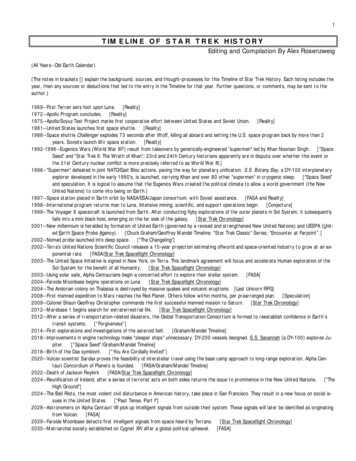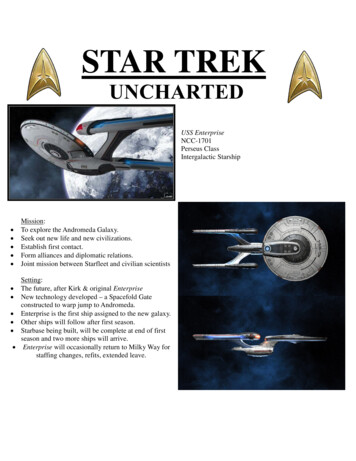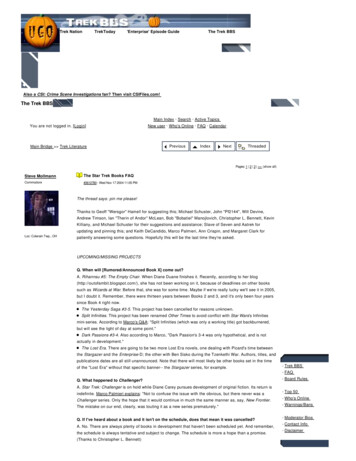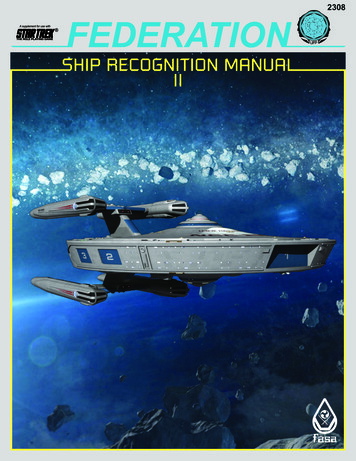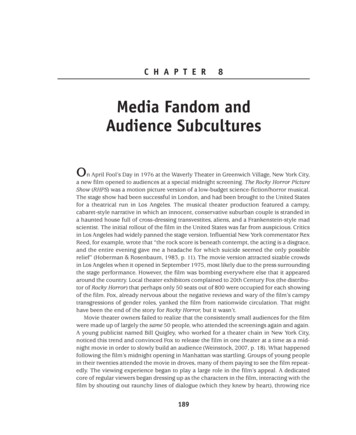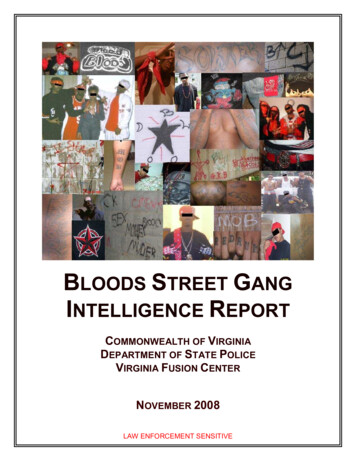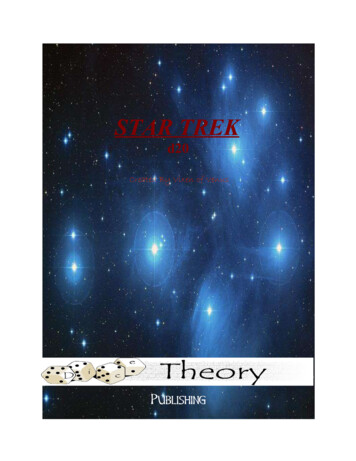
Transcription
STAR TREKd20Created By Vixen of VenusPublishing
STAR TREK D20Section Zero – Author’s Note:As a fan of Star Trek and the d20 system, I havewanted a d20-based Star Trek RPG for quite a while. Myfirst attempt at a d20 Star Trek RPG was based primarily onthe Star Wars RPG by Wizards of the Coast, but no matterhow much I tweaked it, it never went well with the testers.So when the d20 Future Sourcebook for the d20 ModernRoleplaying Game arrived, I knew I could start over and theproblem’s I’d had before wouldn’t be there.It was all a matter of simplicity. By making things likestarship combat and skills more simplistic and lesscomplicated, the system would work and would allow for thestories that make Star Trek unique to be fleshed out, andthe stories would become the focus of play, not the systemitself. So, instead of a complete d20 RPG, this is just asetting to be used with the d20 Future Sourcebook and thed20 Modern Roleplaying Game. I used both booksextensively when creating this setting as well as the StarTrek Player’s Guide and Star Trek Narrator’s Guide made byDecipher. I also kept episodes of the Original Series, DS9,and Voyager playing almost constantly while writing this up.This d20 setting is completely free and can be reproduced,changed, and reproduced again as long as it remains freeand I at least get a nice little mention.Vixen of VenusSection One – Setting Summary:Setting: The Star Trek Universe as seen in films,television, books, and comics.Needed: To play in this setting, the d20 ModernRoleplaying Game and d20 Future Sourcebook are needed.References to feats, skills, classes, advanced classes, andrules are from those two books. I also recommend theDecipher Star Trek RPG products for GM’s who want moresource materials for campaigns, aliens, etc.Progress Level: Somewhere between PL 7 and PL 9.Almost all PL 8 equipment is available in some form oranother, but many technologies are different in shape andform due to the nature of the Star Trek Universe. Also,because there are multiple time periods some objectsavailable in say the “Next Generation Era” (24th century)would not be available in the “Original Series Era” (23rdcentury). Check with the Game Master for specificavailability and design.Computer Use Skill: Most campaigns set in the Star TrekUniverse will revolve around space travel and the high levelof technology. Because of this, the Computer Use skill isalways treated as a class skill in this setting.Dangerous Times: The Star Trek Setting as presentedhere with the rules of the d20 Modern Roleplaying game isvery dangerous. Phasers and disruptors, massive damagethresholds, and stun/kill settings all contribute to a settingwhich is quite easy for characters to get killed in. But themodern medical technology also offsets this danger slightly.It is important for GM’s to remind their players that inthe Star Trek Universe, people more often use cover &concealment than in settings like D&D or Star Wars.Players who take this advice seriously will find theircharacters live much longer, while those who still charge intobattle against a dozen Jem’Hadar shock troops armed withdisruptors will quickly find themselves vaporized.For GM’s who don’t want such a serious setting fortheir Star Trek RPG have a few options. GM’s can alwayseliminate the massive damage threshold rule and use theless dangerous optional kill setting rules below.Section Two – Common Species:The Star Trek universe has an amazing variety of alienspecies, each with its own unique outlook, civilization,history, allies, foes, and appearance. Most alien specieshave their own homeworlds and colonies, but individuals ofa species can be found almost anywhere and everywheredue to the prevalence of warp travel. The lure of adventure,exploration, profit, and power often brings members of manydifferent kinds of species to spaceports, industrial cities, orplanets like Earth, which is the capital of the Federation ofPlanets.Choosing a Species: After you roll your ability scores andbefore you assign them to specific abilities, choose yourcharacter’s species. (If you want to play an androidcharacter with artificial intelligence, and your GM approves,see Chapter Ten: Robotics of the d20 Future Sourcebook.)At the same time, you’ll want to select a class, since speciesaffects how well a character can do in each class. Onceyou’ve decided your character’s species and class, assignyour ability scores to specific abilities. Adjust the scoresaccording to the species and continue detailing yourcharacter.You can play a character of any species presented inthis chapter and of any basic class, but certain species dobetter pursuing certain careers.Your character’s species provides plenty of clues as towhat sort of individual the character is, how the characterfeels about members of other species, and what motivatesthe heroic drive within the character. Remember, however,that the species descriptions only apply to the majority ofindividuals. In each species, some individuals diverge fromthe norm, and your character can be one of these. Don’t leta description hinder you from detailing your character as youlike.All Non-Human species start with four less skill pointsand gain one less skill point per level.HumansEver since the discovery of warp travel and thesubsequent first contact with Vulcans, humans have beenone of the fastest expanding races in the universe. Theirnatural affinity for exploration and adventure has quicklymade them one of the dominant species in the AlphaQuadrant. Compared to other space-faring cultures, humanculture is very young, having developed over only the last25,000 years.Humans don’t have only one culture, but because theirhomeworld was divided into nation-states for thousands ofyears, many different cultures developed, and in latercenturies when intermarriage and other cross-culture unions
became prevalent, a mix of human cultures were found inevery home. For example, Captain Benjamin Sisko has acombination of African, American, and Cajun culture. But acombination of culture is not always present, both Dr. JulianBashir and Captain Jean-Luc Picard have drawn theircultures from a primary source.Personality: Human personality runs the gamut ofpossibilities, though members of this species tend to beadaptable, tenacious, and willing to keep striving no matterthe odds. They are flexible and ambitious, diverse in theirtastes, morals, customs, and habits.Physical Description: Humans average about five and ahalf to six and a half feet in height. Skin shades run fromnearly black to very pale, hair from black to blonde. Men areusually taller and heavier than women. Humans achievematurity about the age of 15 and rarely live beyond 100.Human Homeworld: Earth (Terra). Humans have primarycolonies on other planets of the Sol system including Marsand the Moon.Language: Federation Standard. A combination of Earthlanguages, primarily influenced by English.Example Names: Jean-Luc Picard, Georgi LaForge,William Riker, Beverly Crusher, Benjamin Sisko, JulianBashir, Catherine Janeway, Hikaru Sulu, James Kirk,Leonard McCoy, Pavel Chekov, Tom Paris.Adventurers: Humans are driven by many things, butadventure is a common one. They adventure in the pursuitof many things, fame, fortune, glory, and knowledge.Human Species Traits·Medium-sized: As Medium-size creatures, Humanshave no special bonuses or penalties due to theirsize.·Human base speed is 30 feet.·Automatic Language: Federation Standard.VulcansThe Vulcans possess a sophisticated, ancient culturewith customs dictated by their devotion to logic. Prior to theteachings of Surak, Vulcans lived in a culture of violenceand war. Surak taught the Vulcans how to bury theiremotions and live by logic. Vulcans live by logic in all walksof their life. They see violence as wasteful, but are logicalenough to know that sometimes, force must be met byforce. When a Vulcan comes to this conclusion, theybecome a formidable foe.Every seven years beginning at age 14, Vulcan malesexperience Pon farr, in which the mating urge emerges withirresistible force. A Vulcan who does not mate suffers afatal neurochemical imbalance. He may also experienceplak-tow, the “blood fever,” when he loses all control of hisemotions and can fight and kill without hesitation.Occasionally, Starfleet physicians have developedelaborate chemical, psychological, or holodeck-based“treatments” for Pon farr episodes. Otherwise, they mustmate or fight for the episode to end.Personality: Vulcans suppress their emotions in favor of arigidly logical approach to life. They frown on displaying orrelying on emotion. They often have difficulty relation toemotional species. But one important thing to rememberabout Vulcans is that they do have emotions, they justchoose not to express them or allow them to cloud theirlogical judgments.Physical Description: Vulcans have the same averageheight and weight as Humans. Their eyebrows possess adistinctive upward slant, and their ears have points. Theirskin tones range from olive to dark brown, in part because ofthe green cast provided by their copper-based blood.Vulcan Homeworld: Vulcan, a harsh, desert world ofscorched plains, rough mountain ranges, and stark beauty inthe Vulcanis system.Language: Vulcan, Federation Standard. Vulcans havebeen members of the UFP for so long, both Vulcan andFederation Standard are spoken fluently amongst theirpopulous.Example Names: Surak, Sarek, Spock, Sybok, Tuvok,Vorik, Lojal, T’Pal, Saavik, Sitak, T’Penna, T’Shanik.Adventurers: Vulcans have a natural affinity to thesciences, which are generally logical. Vulcans often leavetheir homes in the pursuit of knowledge and science. AsVulcan is a member of the UFP, Vulcans rarely leave forpower, glory, or wealth.Vulcan Species Traits········ 2 Strength, 2 Intelligence, -4 Charisma. Vulcansare highly intelligent and are born with physicalstrength, but others find their emotionless conduct tobe off-putting.Medium-sized: As Medium-size creatures, Vulcanshave no special bonuses or penalties due to theirsize.Vulcan base speed is 30 feet.Keen Hearing: Vulcans have especially sharphearing. They gain a 2 racial bonus to Listenchecks.Rapid Healing: When injured, Vulcans concentratetheir strength, blood, and antibodies onto injuredorgans by a type of self-induced hypnosis. When aVulcan has hit point damage, he can choose to enterthis hypnosis and instead of naturally healing 1 hitpoint per character level per night of rest, in thisstate of hypnosis, the Vulcan can heal 1 hit point percharacter level per hour of rest.Mind-Meld: This Vulcan discipline allows them toshare memories with another character. Vulcanphilosophical and logic training has taught them howto use this skill. Vulcans have the ability to use thefollowing Psionic powers (found in the d20 ModernCore Rulebook) a number of times per day asindicated, some powers are only available once thecharacter reaches a certain level (representingexperience with Mind-Melds):oLesser Mindlink (A number of times per dayequal to the Vulcan’s character level)oDetect Thoughts (A number of times per dayequal to the Vulcan’s character level divided bytwo, rounded down to a minimum of once perday)o Mindlink (Two times per day after 5th level)ooForced Mindlink (Once per day after 8th level)Mindprobe (Once per day after 10th level)Nerve Pinch: Vulcans automatically gain the NervePinch feat found on page 13 of the d20 FutureSourcebook. Vulcans are not required to meet theprerequisites for this feat.Automatic Language: Vulcan and FederationStandard.KlingonsKlingon culture is dominated by a warrior ethos andmilitary matters. Klingon philosophy dates back to Kahlessthe Unforgettable, the first Klingon Emperor. Due to Klingonphilosophy, honor is held above all other things in Klingon
society. After honor, a Klingon’s House and family are alsohighly important.Running from battle, killing prisoners, using poisons,breaking one’s sworn word, and disloyalty to family, House,and superiors are considered dishonorable acts. AKlingon’s honor reflects not only on himself, but also hisimmediate family and fellow House members. A Klingonwho rejects or violates this code suffers the scorn andapprobation of his fellows.For a brief period, following their first contact withStarfleet, the Klingon’s abandoned their traditional way oflife. Instead, they adhered to a totalitarian, centralizedauthority that transcended both honor and House. Theprimary consideration was to serve the Empire, expand itsborders, and prove the Klingon way as superior. With theexplosion of Qo’noS’s moon, Praxis, the Klingons could nolonger maintain an expensive centralized government andreturn to their traditional way of life.Personality: Klingons are aggressive, brutal, blunt, andtough. They say what’s on their minds, approach problemsdirectly, do not back down from confrontations, and tend toresolve difficulties with violence. Most subscribe to a codeof personal honor.Physical Description: The typical Klingon is taller,broader-shouldered, stronger, and tougher than the averageHuman. Klingons have dark brown skin and dark eyes. Aset of bony ridges, distinctive to each Klingon, adorns theirhigh foreheads and sometimes descends down to the bridgeof the nose. Both sexes wear their black hair long andflowing (or occasionally, tied back in a ponytail).Klingon Homeworld: Qo’noS (pronounced “KRO-nos”), adark and stormy world, capital of the Klingon Empire.Language: Klingon.Example Names: Klingons go by their given names only,though many belong to or serve a House. Chang, Worf,Kor, B’Elanna, Lursa, B’Etor, Koloth, Kahless, Kang,Gowron, Kurn.Adventurers: It is natural for Klingons to leave their homein search of power, glory, and honor. This ideal is burnedinto them from an early age. But since money equalspower, Klingons are always on the lookout for a moneymaking opportunity.Klingon Species Traits· 2 Strength, 2 Constitution, -2 Intelligence, -2Wisdom, -2 Charisma. Klingons are strong andtough, but their warrior culture tends to have themfocus on that prowess and their mental abilitiessuffer. Also, their violent and abrupt nature tends tomake others feel uneasy around them.·Medium-sized: As Medium-size creatures, Klingonshave no special bonuses or penalties due to theirsize.·Klingon base speed is 35 feet.·Klingon Weaponry: Klingons begin teaching theirchildren at an early age how to wield weapons. Assuch, all Klingons automatically gain the followingfeats:oExotic Weapon Proficiency (bat’leth)oExotic Weapon Proficiency (d’k tahg)····oExotic Weapon Proficiency (mek’leth)Brak’lul: Klingons possess duplicates of many oftheir vital organs—they have an eight-chamberedheart, two livers, and twenty-three rib pairs. Thisredundancy, called brak’lul, makes it much harder tokill, incapacitate, poison, and infect them withdiseases. Brak’lul gives Klingons a 3 speciesbonus to Fortitude saves. Brak’lul also makesKlingons harder to incapacitate with a weapon’s stunsettings. When hit with a weapon’s stun effect,divide the effect’s duration in half (round down) to aminimum of zero.Klingon Rage: When necessary, Klingons can flyinto a frenzy. In a rage, a Klingon gains phenomenalstrength (even for a Klingon) and durability, butbecomes reckless and less able to defend himself.He temporarily gains 4 Strength, 2 vitality pointsper level, and a 2 rage bonus on Fortitude and Willsaves, but suffers a -2 penalty to Defense.While raging, a Klingon cannot use skills or featsthat require patience and concentration, such asStealth, Combat Expertise, or any Psionic-basedskill. A fit of rage lasts for a number of rounds equalto 5 the character’s Constitution modifier. At theend of this duration, the Klingon loses the bonusvitality points gained from the rage and is fatigued(-2 penalty to effective Strength and Dexterity, can’trun or charge) for a number of rounds equal to therage’s duration.Honor: Klingons put a high value on their reputationas honorable warriors. An honorable Klingon cancount on the support of other Klingons in times ofneed, while dishonorable Klingons are frequently thetargets of attack or even banishment (calleddiscommodation).A Klingon with high Honor (measured by Reputation)can persuade others to join him in a quest, ally withhim politically, or join him under his banner. AKlingon gains enhanced benefit from his Reputation,improving his chances to persuade another Klingonto assist him or intimidating a fellow Klingon intosubmission (both because of his status).A Klingon’s honor modifies his social interactionswith other Klingons. When making Diplomacy, Bluff,Intimidate, and Gather Information checks involvingother Klingons, the character adds his Reputationmodifier to the skill test, if he is consideredhonorable. If he is considered a dishonorableKlingon, or has been discommodated, it applies as apenalty to those checks.Feats like Fame and Infamy do not affect whether aKlingon is considered honorable by other Klingons.Being infamous for committing crimes against theFederation, for example, could be viewed ashonorable to many Klingons. On the other hand,being famous for being the only Klingon in Starfleet,for example, could be viewed as dishonorable tomany Klingons.Automatic Language: Klingon.BetazoidsBetazoids possess a rich culture dating backthousands of years. According to semi-historical accounts,the mighty Khrysaros, and later his disciple Rixx, used theirmental powers to defeat Betazed’s enemies and inspired theplanet to unify under a theocratic oligarchy.Their society is strongly matriarchal, with women leadingmany of the Great Houses of Betazed, and thus occupyingseats on the ruling council, though they do not discriminatebased on gender.Betazoid culture and society are largely based ontelepathy. Betazoids rarely speak with each other, preferringtelepathic communication, so an eerie silence (to nontelepaths) fills many of their buildings and cities. Much ofBetazoid art has images, visions, and themes telepathicallyimbedded in the object, which the observer then experiencesby scanning it.
Most Betazoids do not like species they cannotunderstand through telepathy or empathy. But someBetazoids seek out those telepathically “mute” species, suchas the Ferengi or Breen, for the relative quiet they feel whenaround them.The famed Code of Sentience governs all Betazoids.Its dictates and ramifications sometimes seem endless, butboil down to two provisions. First, a Betazoid respects allsentient life as sacred, even the lives of his enemies, andharms sentients only in dire need. Second, a Betazoidnever uses his telepathic abilities on another person withoutpermission (or to provide emergency aid). A Betazoid whoviolates the Code suffers not only harsh legal penalties, butalso the scorn and rejection of his fellows.Personality: The typical Betazoid is calm, quiet, peaceful,gregarious, and amicable. Betazoid altruism andcompassion are renowned throughout the galaxy. Manypeople regard Betazoids as pacifistic, and while many ofthem are, this is by no means a universal trait, as theJem’Hadar learned to their dismay during the occupation ofBetazed.Physical Description: Betazoids appear much likehumans, but tend to have skin tones ranging from pink toolive, and black or brown hair. Although the darker skintones and lighter hair are not unknown amongst them.Betazoid Homeworld: Betazed, a beautiful, temperateworld orbiting a star of the same name.Language: Betazoid, Federation Standard. Like Vulcans,Betazoids are a long time member of the UFP, and as suchgrow up speaking their home language and FederationStandard.Example Names: Deanna Troi, Lwaxana Troi, ReittanHagen, Tam Elbrun, Jemma Suder.Adventurers: Their natural telepathic abilities often guidethem to professions dealing with other people such ascounselors, scientists, doctors, diplomats, and merchants.Betazoid Species Traits· 2 Wisdom, 2 Charisma , -2 Strength. Betazoidsexude confidence and strong personal magnetism.They are generally wise and observing, quick tolisten, and watch. But they are not as strong as theaverage human.·Medium-sized: As Medium-size creatures,Betazoids have no special bonuses or penalties dueto their size.·Betazoid base speed is 30 feet.·Peaceful: Betazoids prefer to settle differencesthrough peaceful means, and Betazoid diplomats arehighly sought after. Betazoids gain a 4 speciesbonus to Diplomacy checks.··Telepathic: Betazoids grow up learning tocommunicate both through voice and throughtelepathy. Betazoids have the ability to use thefollowing Psionic powers (found in the d20 ModernCore Rulebook) a number of times per day asindicated, some powers are only available once thecharacter reaches a certain level (representingexperience with Mind-Melds):oDetect Psionics (At will)oMissive (At will)oObject Reading (At will)Automatic Language: Betazoid, FederationStandard.
BajoransBajoran culture and history began approximately30,000 years ago. Through two multiple-millennia republics,periods of balkanization and chaos, and a brutal occupationby the Cardassians, it has remained largely unified andcoherent. The Bajoran religion, which forms the cornerstoneof the culture, centers on the worship of enigmatic beingsknown as the Prophets, who live in the Celestial Temple (theBajoran Wormhole). Through their sacred texts andhundreds of prophecies recorded over the ages, Bajoransattempts to understand the will of the Prophets and liveaccording to their wisdom. An elaborate hierarchy ofreligious officials—ranjens, prylars, and vedeks, all underthe guidance of the kai—guides and teaches the Bajoransand participates in planetary government via the VedekAssembly.People all over the Alpha Quadrant also know Bajor forits art. From painting and sculpture to literature and song,the Bajorans produce works of art, both religious andsecular, envied and admired by many other civilizations.Sales of artistic and craft products form a significant part ofBajor’s interstellar economy.Probably the most recent major event to shape modernBajor was the sixty-year long Cardassian occupation. Whatoriginally started with the Cardassians holding out a helpfulhand and becoming the friend of the Bajorans, quicklyturned to an occupying force of soldiers, forced labor inmining camps all across Bajor, and harsh cruelty from theCardassians.The Vedek Assembly went into hiding, and its first actwas to abolish the D’jarra caste system, making all Bajoranscaste-less and therefore able to handle weapons. TheBajoran Resistance movement was quickly formed. Aftersixty years of resistance, under internal pressure, theCardassians withdraw from Bajor, and the Bajorans, with acrippled economy, petitioned the Federation for aid.The Federation agreed to begin moving towardsmaking Bajor a member of the UFP, and they begin bymaintaining a presence and managing the formerCardassian mining facility, Terok Nor. They renamed thefacility Deep Space Nine, and posted Commander BenjaminSisko to lead the Federation presence. Soon after hisarrival, he discovered the Bajoran Wormhole and wasnamed Emissary to the Bajoran people by the wormholealiens (Prophets).Personality: Most Bajorans are peaceful, contemplativepeople who simply wish to live in peace with their family andneighbors. The Cardassian occupation, however, turnedmany Bajorans into ruthless, passionate soldiers willing todo anything to protect their homeworld from threats to itsindependence and security.Physical Description: Bajorans possess the sameaverage height, weight, and variations in skin tone and haircolor as Humans. The only outward physical difference is aseries of vertical ridges along the bridge of the nose. MostBajorans wear distinctive earrings on their right ears todisplay their devotion to the Prophets. In times past, thedesign of the earring also revealed a Bajoran’s caste, butmany modern Bajorans have discarded that tradition.Bajoran Homeworld: Bajor, the seventh of fourteenplanets orbiting Bajor-B’hava’el, is a pleasant world similar inmost respects to Earth. It is the closest habitable planet tothe only known stable wormhole in the universe, and isorbited by Deep Space Nine, a Federation-administratedBajoran space station.Language: BajoranExample Names: Bajorans place their given name second,and their family name first. For example, Kira Nerys, Kira isher family name. Winn Fala, Ro Laren, Shakaar Pol, andAnjohl Edon are some other examples.Adventurers: Most Bajorans are just content to live athome on Bajor or one of the Bajoran colonies and live theirlives in a simple nature, studying the Prophets teachings,farming, or following a simple profession that does not takethem away from their homes and families. However,because of the displacement caused by the CardassianOccupation, many Bajorans have left their home for amyriad of reasons.Bajoran Species Traits· 2 Charisma. Bajorans are naturally beautiful andcharismatic.·Medium-sized: As Medium-size creatures, Bajoranshave no special bonuses or penalties due to theirsize.·Bajoran base speed is 30 feet.·Willful: Since the occupation of their planet,Bajorans have shown an inner strength of will.Bajorans have a 3 species bonus to Will savingthrows.·Artistic: Bajorans are generally artistic, and mostBajorans practice some form of artistic expressionas a hobby. Bajorans always consider the Craft skilla class skill, no matter what class they are and gaina 2 species bonus to all Craft skills they have atleast one rank in.·Faithful: Religion permeates Bajoran society asevery child learns to respect the Prophets and theirteachings. Even those who reject the Prophets cancite quotes from the Sacred Texts and know theproper rituals. Bajorans gain a 2 species bonus toKnowledge (religion) checks.·Automatic Language: Bajoran.CardassiansThe Cardassians once possessed a rich, vibrantculture, but because their world has few resources, theyeventually found themselves ignoring loftier matters toconcentrate on simple survival. The result was veresh-var,a gradual decline of Cardassian civilization that lasted forcenturies. Art and religion were abandoned in a desperatestruggle for survival that gave rise to a harsh militarydictatorship. All Cardassians were expected to serve theneeds of the state, from providing a molar for identificationpurposes to living under strict authoritarian laws.By the 23rd and 24th centuries, the Central Command(military) and the Obsidian Order (intelligence agency)dominated Cardassia. Necessarily harsh and aggressive,the Cardassians turned outward to solve their resourceproblems. Their first encounter with the Klingons led to aneighteen-year-long war. Similarly, they approached theirearly encounters with the Federation with suspicion andmistrust, perhaps seeing the Federation as a competitor forresources and hindrance on their ability to expand. Themost infamous example of their ruthless exploitation of otherworlds can best be seen on Bajor.Although this militaristic culture lauded devotion to thestate and purported to reward citizens based on merit,personal contacts and influence (vesala) were what reallymattered. Among Cardassians, who you know is moreimportant than what you know. Another Cardassian traditionto survive is devotion to one’s family; Cardassians typicallygive preference to family members over outsiders, whichsometimes leads to someone holding a position not becauseof their abilities, but rather because of a well-placed relative.The price for failure, however, ranges from exile to death, soeven the most undeserving officer quickly learns his job.
After the Dominion War, which left over 800 millionCardassians dead, they may chart a newer, better courseand leave veresh-var behind or continue down the sameterrible path.Personality: Most other species regard Cardassians asaggressive, harsh, and xenophobic. Cardassians arecapable of great cleverness, cunning, and eloquence.Physical Description: Descended from a species withreptilian and mammalian traits, Cardassians have gray skinand black hair. They are as tall as, but slightly heavier andbroader than, Humans. Elongated vertebrae covered withscale-like plates support their necks. Segmented browridges almost encircle their eyes; they have slightly lesspronounced unsegmented ridges along the nose, chin, andjaw line. A chufa, or spoon-shaped vertical protrusion,stands out from the center of the forehead.Cardassian Homeworld: Cardassia Prime, the third ofeight planets orbiting the star Cardassia.Language: Cardassian.Example Names: Rugal Marritza, Elim Garak, Iliana Dukat,Talarn Damar.Adventurers: Since Cardassia looks outward into thegalaxy for natural resources and sources of income, many ifnot all Cardassians travel to other planets and colonies. AllCardassian males are required to serve in the military for ashort period. Other Cardassians often tend toward theRogue class, serving the Obsidian Order.Cardassian Species Traits· 2 Wisdom, 2 Constitution , -2 Dexterity, -2Charisma. Cardassians are observant, but theirxenophobia and arrogance cause them to be fairlyuncharismatic. Their anasi-reptilian physiologymakes them more rugged, but a bit slower.·······Medium-sized: As Medium-size creatures,Cardassians have no special bonuses or penaltiesdue to their size.Cardassian base speed is 30 feet.Eidetic Memory: All Cardassians receive intensemental training during childhood. Cardassiansreceive a 2 species bonus to all Knowledge skillchecks.High Pain Threshold: Cardassians have anextremely high tolerance for pain. Cardassiansautomatically receive the Improved DamageThreshold feat.Devious: Cardassians are naturally inquisitive,devious, and often prying. Cardassians gain a 2species bonus to Bluff, Intimidate, and SenseMotive.Vesala: Corruption, influence peddling, graft, andnepotism afflict Cardassian society—often it’s who aCardassian knows, not what he knows, that matters.Every Cardassian has vesala, a vast and elaborateweb of personal contacts, influence, and friends whohelp
STAR TREK D20 Section Zero – Author’s Note: As a fan of Star Trek and the d20 system, I have wanted a d20-based Star Trek RPG for quite a while. My first attempt at a d20 Star Trek RPG was based primarily on the Star Wars RPG by Wizards of the Coast, but no matter ho
